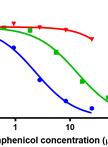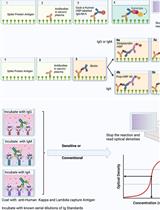- Submit a Protocol
- Receive Our Alerts
- Log in
- /
- Sign up
- My Bio Page
- Edit My Profile
- Change Password
- Log Out
- EN
- EN - English
- CN - 中文
- Protocols
- Articles and Issues
- For Authors
- About
- Become a Reviewer
- EN - English
- CN - 中文
- Home
- Protocols
- Articles and Issues
- For Authors
- About
- Become a Reviewer
Quantitative Enzyme-linked Immunosorbent Assay (ELISA) to Measure Serum Levels of Murine Anti-cardiolipin Antibodies
Published: Vol 2, Iss 12, Jun 20, 2012 DOI: 10.21769/BioProtoc.227 Views: 13779

Protocol Collections
Comprehensive collections of detailed, peer-reviewed protocols focusing on specific topics
Related protocols

Mitochondrial Biogenesis Assay after 5-day Treatment in PC-3 Cells
Yili Xu and Joy Y. Feng
Jan 20, 2015 12039 Views
Determining Ribosome Translational Status by Ribo-ELISA
Amandine Bastide [...] Alexandre David
Jan 5, 2018 7855 Views

An Optimised Indirect ELISA Protocol for Detection and Quantification of Anti-viral Antibodies in Human Plasma or Serum: A Case Study Using SARS-CoV-2
Claire Baine [...] Jennifer Serwanga
Dec 20, 2023 3608 Views
Abstract
The circulating anticardiolipin antibody is a hallmark of antiphospholipid syndrome. It also appears in a number of autoimmune mouse models and is indicative of the break of tolerance against self antigens. This protocol describes a reliable method to determine the relative serum titer of anticardiolipin in autoimmune mouse models.
Keywords: MouseMaterials and Reagents
- Cardiolipin (Sigma-Aldrich, catalog number: C0563 )
- Ethanol
- Phosphate buffered saline (PBS)
- Tween 20
- Na2HPO4 (anhydrous)
- NaH2PO4 (anhydrous)
- NaCl
- Fetal bovine serum (FBS) (Hyclone)
- Bovine serum albumin (BSA)
- Horseradish peroxidase (HRP) conjugated goat anti-mouse isotype specific antibodies [Southern Biotech, catalog number: 1040-05 (IgA); 1030-05 (IgG); 1021-05 (IgM)]
- ABTS Peroxidase Substrate Solution A and B (Kirkegaard & Perry Laboratories, catalog number: 50-62-01 )
- ABTS Peroxidase Stop Solution (Kirkegaard & Perry Laboratories, catalog number: 50-85-01 )
- 10x PBS-Tween 20 (see Recipes)
- Blocking solution (see Recipes)
Equipment
- Standard bench-top centrifuge
- Immulon 2HB plates (Fisher Scientific, catalog number: 14-245-61 )
- ELISA reader
Procedure
- Add 100 μl/well of 75 μg/ml cartiolipin in ethanol to an Immunlon 2HB plate and allow it to dry at room temperature.
- Add 100 μl of blocking solution per well and block the plate at room temperature (RT) for 90 min.
Note: FBS is the source of beta glycoprotein I.
- Discard the blocking solution and wash the plate four times with 120 μl/well PBS.
Note: Washes can be done with an ELISA plate washer or by manually pipeting in and out PBS.
- Dilute the mouse serum in 1% BSA in PBS and add 100 μl/well in duplicates or triplicates to the plate.
Note: A 1:500 dilution generally gave us optimal results of serum levels of anti-cardiolipin in 12-22 week old male and female NZW x BXSB F1 mice. Titration is recommended to achieve optimal detection.
- Make serial dilutions of a high titer serum sample and add the serial dilution to the plate.
- Incubate the plate at 37 °C for 2 h.
- Discard the diluted serum and wash the plate with 1x PBS-Tween 10 times.
- Add 100 μl/well of HRP conjugated goat anti-mouse isotype specific antibodies (1/4,000 in 1% BSA/PBS) to the plate and incubate at 37 °C for 1 h.
- Wash the plate with 1x PBS-Tween 10 times.
- Add 100 μl/well of 1:1 mix of ABTS Peroxidase Substrate Solution A and B to the plate.
- Develop the plate at RT in dark. Incubation times will vary depending on your assay.
- Stop the reaction by adding 100 μl/well of ABTS Peroxidase Stop Solution.
Note: The plate needs to be read within 30 min once the reaction is stopped.
- Read the plate using an ELISA reader with a wavelength of 410 nm.
- Calculate the concentration of the serum samples using the standard curve established with the serial dilutions of the high titer serum sample.
Recipes
- 10x PBS-Tween 20 [0.1 M PBS, 0.5% Tween 20 (pH 7.4)]
Mix to dissolve and adjust pH to 7.4 and then add 5 ml of Tween 20, store this solution at RT. Dilute 1:10 with distilled water before use and adjust pH if necessary.Na2HPO4 (anhydrous)
10.9 g
NaH2PO4 (anhydrous)
3.2 g
NaCl
90 g
Distilled water
1,000 ml
- Blocking solution
5% FBS and 3% BSA in PBS
Acknowledgments
This protocol was developed or modified in Dr. Anne Davidson’s lab at Feinstein Institute for Medical Research, NY, USA. This work was supported by grants from the NY SLE Foundation (RB), Rheuminations, NIH AI082037 and AR 049938-01, NIH (PO1 AI51392 and the Flow Cytometry and Protein Expression and Tetramer Cores of PO1 AI51392).
References
- Kahn, P., Ramanujam, M., Bethunaickan, R., Huang, W., Tao, H., Madaio, M. P., Factor, S. M. and Davidson, A. (2008). Prevention of murine antiphospholipid syndrome by BAFF blockade. Arthritis Rheum 58(9): 2824-2834.
Article Information
Copyright
© 2012 The Authors; exclusive licensee Bio-protocol LLC.
How to cite
Liu, Z. (2012). Quantitative Enzyme-linked Immunosorbent Assay (ELISA) to Measure Serum Levels of Murine Anti-cardiolipin Antibodies. Bio-protocol 2(12): e227. DOI: 10.21769/BioProtoc.227.
Category
Immunology > Antibody analysis > Antibody detection
Biochemistry > Protein > Immunodetection > ELISA
Immunology > Animal model > Mouse
Do you have any questions about this protocol?
Post your question to gather feedback from the community. We will also invite the authors of this article to respond.
Share
Bluesky
X
Copy link







